Pluto Surface Observations 1: NH Post-Encounter Phase, 1 Aug 2015- 10 Oct 2015 |

  |
Pluto Surface Observations 1: NH Post-Encounter Phase, 1 Aug 2015- 10 Oct 2015 |
 Sep 12 2015, 07:01 AM Sep 12 2015, 07:01 AM
Post
#211
|
|
 Member    Group: Members Posts: 813 Joined: 8-February 04 From: Arabia Terra Member No.: 12 |
I'm surprised at how many uncompressed images they have on the ground so far! Is this torrent of awesomeness really going to continue all the way into 2016?
|
|
|
|
 Sep 12 2015, 09:06 AM Sep 12 2015, 09:06 AM
Post
#212
|
|
 Member    Group: Members Posts: 120 Joined: 26-May 15 From: Rome - Italy Member No.: 7482 |
New horizon can be estimate a temperatures maps for Charon and Pluto? and it possible future more best high resolution images more big of the last images?
Grazie! |
|
|
|
 Sep 12 2015, 03:33 PM Sep 12 2015, 03:33 PM
Post
#213
|
|
 Member    Group: Members Posts: 423 Joined: 13-November 14 From: Norway Member No.: 7310 |
It's not just the Tombaugh region that has young surfaces. These plains/areas are remarkably crater-free (or nearly so):
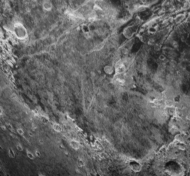 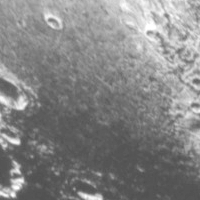 The first one is interesting in that it appears at the end of those valleys (I am probably not the only one who has had their eyes on it for a while). I also noted this crater in what appears to be an ice-covered area to the north: 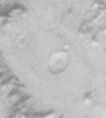 Either the ice cover is shallow, or the crater is young - since, presumably, it would otherwise have relaxed considerably by now (no?). Also, there is this: 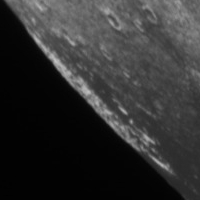 This appears as a bright circular feature on the map. It would be natural to assume that it is a crater - though other craters in the area are mostly as dark as the surroundings; so something would then have to be different about it. I'm surprised at how many uncompressed images they have on the ground so far! Is this torrent of awesomeness really going to continue all the way into 2016? I am also wondering how they are going to spend about a year downloading data. Maybe the size of the spectra and colour data is the primary cause? I noticed this to the North West of Tombough Regio too No obvious signs of flow there, though. It might be that north polar ice is more inert. -------------------- |
|
|
|
 Sep 12 2015, 04:22 PM Sep 12 2015, 04:22 PM
Post
#214
|
|
 Senior Member     Group: Members Posts: 1887 Joined: 20-November 04 From: Iowa Member No.: 110 |
|
|
|
|
 Sep 12 2015, 04:55 PM Sep 12 2015, 04:55 PM
Post
#215
|
|
|
Member    Group: Members Posts: 137 Joined: 16-June 15 Member No.: 7507 |
I don't think it requires anything like "ice floods". Remember, water ice is lighter than nitrogen ice, not heavier. Water ice floats on nitrogen ice; it's not a "natural" situation for large amounts of nitrogen ice to be on top. Remember, the NH's leading team is that the jumbled mountains in places around Sputnik is that they're literally floating on the nitrogen ice and drifted to their current locations with the flow of the glacier.
The thing that seems the easiest to me to picture is that Pluto has a thin water ice crust atop a denser nitrogen ice mantle (of unknown thickness), which flows - the forces driving the flow being some combination of nitrogen sublimation and seasonal heading/cooling stress, probably mainly the former. Hence whenever a meteor punches through the water ice, it exposes the nitrogen ice mantle (which would of course relax into the gap). The Sputnik side of Pluto would be an area where the ice crust is thinner, with the opposite side of the planet having a thicker ice crust and thus harder to punch through. Hmm, thought... where is Charon tidally locked relative to Sputnik? Liquids may also play a role on Pluto, but never on the surface (not for more than very brief periods, at least) - certainly they're not carving canyons. But in the right conditions they could exist underground. That said, I'm not sure if it really even makes that much of a difference, these nitrogen ices seem to be plenty sufficient for viscous flow over the scales at hand. I strongly suspect that all of these canyons are tectonic, driven by movement of the nitrogen ice mantle. If this thing is dragging *mountains* along, we shouldn't play down the scale of the forces at hand here, they should be more than ample to create large-scale tectonic formations. |
|
|
|
 Sep 12 2015, 05:39 PM Sep 12 2015, 05:39 PM
Post
#216
|
|
 Junior Member   Group: Members Posts: 82 Joined: 13-July 15 Member No.: 7579 |
Remember, water ice is lighter than nitrogen ice, not heavier. Water ice floats on nitrogen ice; it's not a "natural" situation for large amounts of nitrogen ice to be on top. Density of HCP nitrogen ice is about 0.88 g/cm^3, but water ice have density about 0.95 g/cm^3 at 40 K. I'm wrong? |
|
|
|
 Sep 12 2015, 05:59 PM Sep 12 2015, 05:59 PM
Post
#217
|
|
|
Senior Member     Group: Members Posts: 3516 Joined: 4-November 05 From: North Wales Member No.: 542 |
I'm finding 1.03 for solid nitrogen by googling around, but I don't know for sure if that's reliable.
|
|
|
|
 Sep 12 2015, 06:58 PM Sep 12 2015, 06:58 PM
Post
#218
|
|||
 Member    Group: Members Posts: 714 Joined: 3-January 08 Member No.: 3995 |
The complexity of Pluto's surface may make interpreting the relative age of craters quite difficult. The variety of modification reminds me of Mars, but sorting out relative ages on Pluto may be even more perplexing. At least on Mars, rocky material tends to stick around, so there may always be some evidence of previous mantling. On Pluto, some surface materials could potentially completely sublime away.
The pair of craters at (1) appear to be fresh, but are they? Crater (2) is heavily modified. Is it a crater on an upper unit that is being eroded? Or is it on a lower unit and is being exhumed? Crater (3) appears fresher than (2), but is that due to its larger size, younger age, geologic circumstances, or a combination? Crater (4) is modified, but the wall on the left is fresh. Is that due to relatively recent slumping of a once degraded wall? Could some 'fresh' craters really be old ones that have had all walls slump recently? So back to (1). It's possible that these are more recent craters on the surface, or they could be older craters that are perfectly preserved after being fully exhumed. Carefully working out the geologic context will be necessary to tell for sure. --------------- Speaking of upper and lower units, there appears to be a 'plateau' unit that covers much of the surface and is being eroded in various ways like this: |
||
|
|
|||
 Sep 12 2015, 07:01 PM Sep 12 2015, 07:01 PM
Post
#219
|
|
 Senior Member     Group: Members Posts: 4246 Joined: 17-January 05 Member No.: 152 |
So a faint glow on the dark side of Pluto on original frame is definetly not Charonshine. May be it is symmetrical relative center a faint reflection in the optic system of LORRI... Thanks for the simulation, Gennady, and to Alan for pointing me to Bjorn's previous simulations. Both of your simulations agree that Charon should be illuminating the right-upper right of that image, so we see no sign of Charonshine. Agreed that internal optical reflections are likely. I don't recall discussion of when Charonshine would be brightest. At NH closest approach (CA), Charon appeared gibbous from Pluto. But it was waning: a day later, it appeared as a crescent. This means that the brightest absolute illumination level of Charonshine was earliest after CA. In addition, the closer NH was to Pluto the easier it would be to image Charonshine since the pixels could be binned if need be. Charon didn't appear as broad a gibbous from Pluto again until about 5 days after CA, when Pluto was much smaller in LORRI's field. At the time of the released post-encounter image in question (roughly 15 h after CA), Charon appeared approximately half illuminated from Pluto. So images taken soon after CA would have higher absolute illumination levels, but not dramatically so. Anyway, with binning we will hopefully see something... |
|
|
|
 Sep 12 2015, 07:17 PM Sep 12 2015, 07:17 PM
Post
#220
|
||
 Senior Member     Group: Members Posts: 1887 Joined: 20-November 04 From: Iowa Member No.: 110 |
This patch reminds me of Hyperion
ETA: QUOTE Speaking of upper and lower units, there appears to be a 'plateau' unit that covers much of the surface and is being eroded in various ways like this: If the lower unit is darker patches that are exposed may be growing as the added heat they absorb is transferred to their surroundings causing an accelerated sublimation of the upper layer. I vaguely remember something like that as an explanation for the dark patches on Iapetus extending to the lighter hemisphere . |
|
|
|
||
 Sep 12 2015, 07:35 PM Sep 12 2015, 07:35 PM
Post
#221
|
|
 Member    Group: Members Posts: 714 Joined: 3-January 08 Member No.: 3995 |
|
|
|
|
 Sep 12 2015, 07:50 PM Sep 12 2015, 07:50 PM
Post
#222
|
|
|
Member    Group: Members Posts: 306 Joined: 4-October 14 Member No.: 7273 |
I put together the full-globe mosaic for myself last night; this morning I decided to highlight all the likely lineations/possible fault traces. There's an interesting pattern to them: the graben walls northwest of Tombaugh Regio are definitely tangential to the basin rim. It also appears that the chaos region might be on a narrow slice of terrain sitting between the easternmost of that fracture set and the western edge of Tombaugh Regio proper.
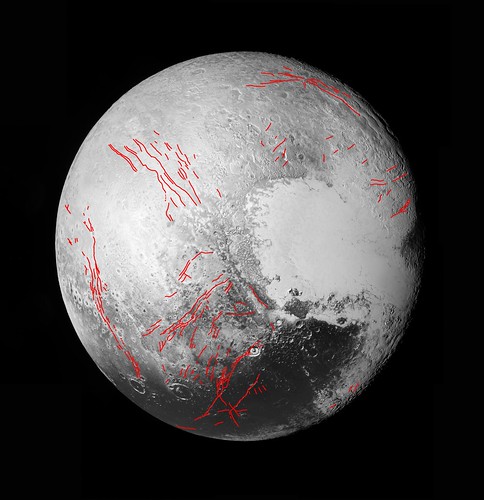 Pluto Fault Map by Justin Cowart, on Flickr (Some users have reported problems with downloading on flickr without an account, so if you're having trouble here's a dropbox link) Another interesting observation is that some of the fracture sets in northern Cthulhu Regio might be running "en eschelon", or in short segments that step sideways along the main fault trace. That's usually a good sign of shear, so I wonder if some of these fractures might represent some transform movement. They're not widespread or very long, suggesting that it's not global tectonics, but it is interesting to see how these areas might have moved around in response to regional forces. Also, it appears to my eye that some of the fractures immediately to the north of Tombaugh Regio are marked by sublimation pits similar to those seen in Martian polar areas. There's so much going on geologically that everywhere you turn there's new terrain features and oddities. |
|
|
|
 Sep 12 2015, 09:48 PM Sep 12 2015, 09:48 PM
Post
#223
|
|
 Senior Member     Group: Members Posts: 1887 Joined: 20-November 04 From: Iowa Member No.: 110 |
|
|
|
|
 Sep 12 2015, 11:07 PM Sep 12 2015, 11:07 PM
Post
#224
|
|
 Member    Group: Members Posts: 714 Joined: 3-January 08 Member No.: 3995 |
I don't think it requires anything like "ice floods". Remember, water ice is lighter than nitrogen ice, not heavier. Water ice floats on nitrogen ice; it's not a "natural" situation for large amounts of nitrogen ice to be on top. Remember, the NH's leading team is that the jumbled mountains in places around Sputnik is that they're literally floating on the nitrogen ice and drifted to their current locations with the flow of the glacier. The thing that seems the easiest to me to picture is that Pluto has a thin water ice crust atop a denser nitrogen ice mantle (of unknown thickness), which flows - the forces driving the flow being some combination of nitrogen sublimation and seasonal heading/cooling stress, probably mainly the former. Hence whenever a glacier punches through the water ice, it exposes the nitrogen ice mantle (which would of course relax into the gap). The Sputnik side of Pluto would be an area where the ice crust is thinner, with the opposite side of the planet having a thicker ice crust and thus harder to punch through. I agree with this assessment. With Sputnik Planum, I think of it as a vast 'lava lake'. But instead of solidifying, it continues to ebb and flow and sublimate as more material is replenished from below. The intricate cellular pattern in various spots seems to imply convection or lobes of material being injected into the mass. With this scenario, the large mountains are 'floating' on the surface. They became detached from the surrounding water-ice rust and eventually become 'impacted' or stranded along the 'shoreline'. The small hills (colles) could be 'xenoliths' of water ice that were plucked from the 'bedrock' and ended up rising to the surface and concentrated in various spots. I know I'm stumbling into speculation territory here, but this is what seems to make sense. |
|
|
|
 Sep 12 2015, 11:15 PM Sep 12 2015, 11:15 PM
Post
#225
|
|
|
Member    Group: Members Posts: 137 Joined: 16-June 15 Member No.: 7507 |
Density of HCP nitrogen ice is about 0.88 g/cm^3, but water ice have density about 0.95 g/cm^3 at 40 K. I'm wrong? Solid nitrogen's density is 1.027 g/cm^3 at its melting point: http://www.aqua-calc.com/page/density-tabl...-blank-nitrogen It should only get denser with decreasing temperature (as a general rule) |
|
|
|
  |

|
Lo-Fi Version | Time is now: 1st May 2024 - 05:41 AM |
|
RULES AND GUIDELINES Please read the Forum Rules and Guidelines before posting. IMAGE COPYRIGHT |
OPINIONS AND MODERATION Opinions expressed on UnmannedSpaceflight.com are those of the individual posters and do not necessarily reflect the opinions of UnmannedSpaceflight.com or The Planetary Society. The all-volunteer UnmannedSpaceflight.com moderation team is wholly independent of The Planetary Society. The Planetary Society has no influence over decisions made by the UnmannedSpaceflight.com moderators. |
SUPPORT THE FORUM Unmannedspaceflight.com is funded by the Planetary Society. Please consider supporting our work and many other projects by donating to the Society or becoming a member. |

|